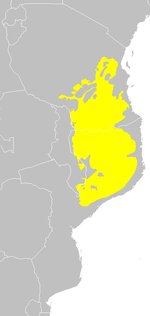Eastern miombo woodlands
| Eastern miombo woodlands | |
|---|---|
 Giraffes in the Selous Game Reserve, Tanzania. | |
 Map of the Eastern miombo woodlands ecoregion | |
| Ecology | |
| Realm | Afrotropic |
| Biome | Tropical and subtropical grasslands, savannas, and shrublands |
| Geography | |
| Area | 483,800 km2 (186,800 sq mi) |
| Countries | Malawi, Mozambique, and Tanzania |
| Conservation | |
| Conservation status | relatively stable/intact |
| Global 200 | yes |
| Protected | 155,682 km2 (32.3%)[1] |
The Eastern miombo woodlands (AT0706) are an ecoregion of grassland and woodland in northern Mozambique, southern Tanzania, and southeastern Malawi.
Setting
These species-rich
The region has a hot, tropical climate with a wet summer from November to March and a long winter drought. The woodlands are vulnerable to fire, particularly at the start of the summer.
Flora and fauna
The predominant tree is miombo (Brachystegia spp.), along with Baikiaea woodland.
Despite the low rainfall and relatively nutrient-poor soil the woodland is home to many species. The miombo and other vegetation in and around the region have historically a variety of food and cover for several miombo specialist endemic bird and lizard species as well as more widespread mammals including herds of
The region is also rich in bird life, including the near-endemic
Reptiles include common crocodiles while the endemics are the two sub-species of the spotted flat lizard, and the chameleon Chamaeleon tornieri (although the validity of this last species classification has been questioned).[3]
People
The ecoregion is thinly populated by humans, partly due to
Conservation and threats
32.3% of the ecoregion is in protected areas.[1] Selous Game Reserve (44,000 km2) is a major element of conservation in this ecoregion, along with Ruaha National Park (14506.7 km2), Niassa Reserve (42,000 km2), and other national parks in Mozambique which suffered during the civil war and are in a state of reconstruction. Smaller protected areas lying mostly within the ecoregion include Mikumi National Park (3233.88 km2) in Tanzania and Gilé National Reserve (2100 km2) in Mozambique.
Even outside protected areas the woodlands have remained comparatively intact due to the sparse human population. However the woodlands are being slowly cleared for farmland and pasture throughout. There is little commercial logging except for the African blackwood (Dalbergia melanoxylon), whose timber is highly valuable. Poaching of elephant and rhino are a threat, especially in Mozambique.
Many areas of miombo woodland are still managed in traditional ways, with
The N'hambita project was launched in 2003 as a collaboration between the environmental company Envirotrade Ltd. and the University of Edinburgh.[4][5] To date (Jan 2009) the project has engaged 1350 farmers or 'producer's in agroforestry and woodland restoration and conservation activities. Those involved have benefited from staged payments, continued technical support and have been encouraged to become involved in other micro-finance initiatives, such as beekeeping and carpentry, using miombo tree species planted within the project.
The Plan Vivo[6] System is used, which was pioneered, and has run successfully in Mexico for over 10 years in the Scolel Te project.[7] Plan Vivo projects are registered and reviewed under standards developed by the Plan Vivo Foundation.[6] Producers who sign up to the scheme must agree to manage their land according to their plan vivo, a long term land management plan evaluated and registered by the local project manager.
Line notes
- ^ a b "Eastern miombo woodlands". Digital Observatory for Protected Areas Explorer 4. Accessed 15 October 2020. https://dopa-explorer.jrc.ec.europa.eu/ecoregion/30706
- ^ Richard Estes. 1999
- ^ J Mariaux, N Lutzman and J Stipala. 2008.
- ^ "Miombo". Archived from the original on 2019-01-07. Retrieved 2022-07-08.
- ^ "Redirection page". Archived from the original on 2013-09-07. Retrieved 2019-08-01.
- ^ a b "Home". planvivo.org.
- ^ "Plan Vivo - Mexico". Archived from the original on 2009-05-19. Retrieved 2012-09-28.
References
- Richard Estes. 1999. The safari companion: a guide to watching African mammals, Chelsea Green Publishing, 458 pages
- C. Michael Hogan. 2009. Painted Hunting Dog: Lycaon pictus, GlobalTwitcher.com, ed. N. Stromberg
- J Mariaux, N Lutzman and J Stipala. 2008. The two-horned chamaeleons of East Africa, Zoological Journal of the Linnean Society, vol 152
External links
- World Wildlife Fund, ed. (2001). "Eastern Miombo woodlands". WildWorld Ecoregion Profile. National Geographic Society. Archived from the original on 2010-03-08.
- "Eastern Miombo woodlands". Terrestrial Ecoregions. World Wildlife Fund.
